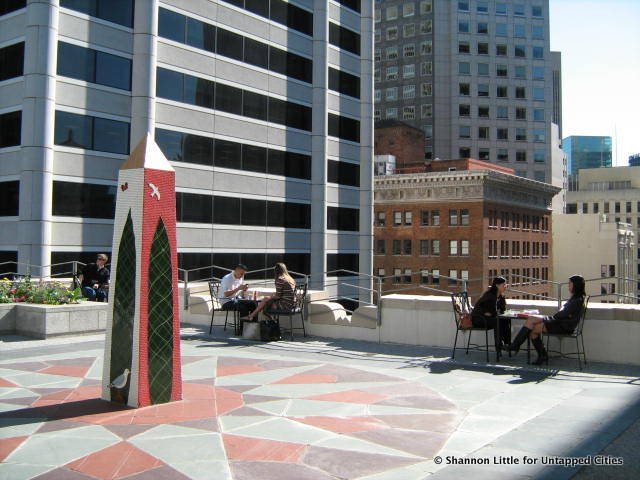 Redwood Grove at the Transamerica Pyramid.
Redwood Grove at the Transamerica Pyramid.
In that standard of oldies radio, “Downtown” (1964), Petula Clark sings about how the bustle of downtown can help you get away from the stresses of your life: “When you’ve got worries, all the noise and the hurry/ seems to help, I know ”” downtown.”
It’s a nice sentiment. But San Francisco’s downtown (the Financial District) has never felt that romantic to me. This is especially true during the daytime when the sidewalks are crowded with office workers rushing to Lee’s Deli or Starbucks. It’s actually pretty stressful down there.
Well, it turns out there is an entire network of mini-oases downtown. These are places where you might actually be able to relax in the midst of the noise and the hurry. They’re privately owned public open spaces (POPOS, for fun), just like the now-famous Zucotti Park in Manhattan.
There are very few publicly owned parks downtown. In their place, the POPOS provide a respite for bike messengers between tags, fresh air for office workers who need a break from their computer screens and co-workers but don’t want to go to a pricey restaurant or a crowded coffeeshop.
 Greenhouse at Sansome and Sutter
Greenhouse at Sansome and Sutter
In all, there are 68 of them in the area covered by the City of San Francisco’s “Downtown Area Plan.” The Downtown Area Plan is based on a philosophy that new development and density creates new needs-like outdoor space for all those office workers-and developers should help to cover the cost of meeting those needs, according to Josh Switzky, of the San Francisco Planning Department.
Although some POPOS predate the Downtown Area Plan, the 1985 plan included specific requirements about the amount of public space that a private developer must provide. According to a 2008 report by San Francisco Planning and Urban Research (SPUR), these provisions are a condition of obtaining development approvals. Standards also relate to things like the hours of public access, the sun and wind exposure, and minimum levels of seating and tables.
The POPOS run the gamut from parks to plazas to urban gardens to walkways. Some, like the redwood grove at the base of the Transamerica Pyramid, a 15th-floor terrace at 343 Sansome, and a sparkling sun terrace at 100 First Street, are total retreats from the rat race-peaceful, removed from traffic, designed with gurgling fountains and mature trees. Others, like a two-story atrium at 101 Second Street and a huge greenhouse built into a former bank building at the corner of Sutter and Sansome, are airy, bright and covered spaces usable even on rainy days. And others, unfortunately, like a narrow strip of seating and tragic planters at 45 Fremont Street or the sterile plaza in front of 101 California (decorated with weirdly plastic-looking and always blooming flowers), feel uncomfortably corporate.

Switzky, of the Planning Department, noted some POPOS are better-and better utilized-than others. His favorites include plazas at 555 Mission Street and 565 Mission Street, which display interesting artwork. Another favorite is Trinity Ally, a roadway closed to traffic and paved with a cobblestone effect. Café tables give it a European feel. He holds these up as model POPOS because they feel public-they are a “natural extension of the public realm and the circulation system,” and they are well integrated with the buildings around them.
Of course, since POPOS are privately owned, they come with a unique set of issues. The San Francisco design group, Rebar, has pointed out that the POPOS are heavily monitored by private building owners. Building owners maintain the POPOS and enforce their own rules. It is likely that security guards shoo away members of the public who don’t look or act like your average office worker. Rebar highlighted this issue in 2007 by holding a mass “nap-in” in an indoor park at 55 Second Street. Despite the humorous tone, the “nap-in” raised serious questions about arbitrary enforcement and unequal access. In addition, while the city has jurisdiction to enforce permit conditions (like hours of public access), enforcement is not the highest priority. Finally, given the drop-off in downtown construction in the past few years, the city has had few hooks to create new spaces or impose new conditions on existing spaces. Switzky said that the city is looking into other mechanisms, like development fees or infrastructure financing districts, that could be used to increase open space downtown. They have not yet been fully explored or implemented.
These are interesting issues. Still, the fact is, I was thrilled to discover that there are so many spots downtown that have been set aside specifically so that I have somewhere to eat my sandwich and do the crossword puzzle. I might not totally agree with Petula that downtown is a place where I can forget all my troubles, forget all my cares (and I hate to think I’m so cheesy that I get my wisdom from oldies radio), but I certainly do have a new interest and enthusiasm to explore and take advantage of as many of the downtown POPOS as I can.
 Greenhouse at 101 Second Street
Greenhouse at 101 Second Street
Click here for a map and guide to all 68 POPOS compiled by SPUR.
Follow Untapped Cities on Twitter and Facebook. Get in touch with the author @shanthrax815.






